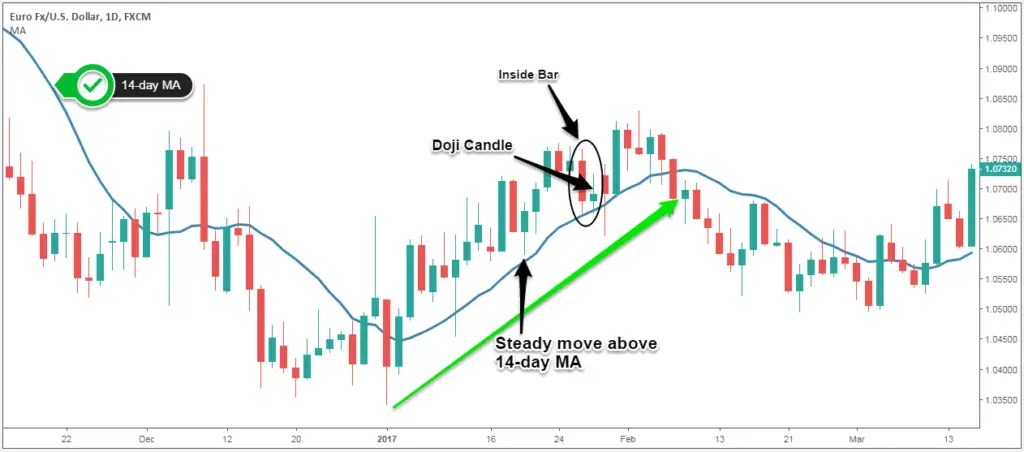The best Doji strategy is a hit and run trading strategy that will give you quick profits. We have a very unique approach when trading this very little candlestick pattern. We’re going to reveal our secret on how to trade Doji Star candlestick.
A lot of the problems when trading the Doji, especially the neutral Doji, are that you’ll get many whipsaws. This often leads to prematurely being stopped out of your trades.
A whipsaw pattern involves price moving chaotically above and below a certain key support and resistance level. Whipsaw patterns are also referred to as false breakouts. We have developed our Japanese Doji trading strategy around this price feature.
What we did is to use to our own advantage the whipsaw pattern in combination with the Doji candle and trend analysis. The whole Japanese candlestick strategy is based on our preferred time frame, the daily chart.
The only technical tool we would need for the Doji trading strategy is a 14-period simple moving average plotted on the daily time frame.
Now, before we go any further, we always recommend taking a piece of paper and a pen and note down the rules of this Doji strategy.
For this article, we’re going to look at the buy side.
Even though most traders used this Japanese candlestick pattern as a reversal pattern, we have found out through some testing that the Doji candle performs best as a continuation pattern. So the first step we need to undertake is to determine the trend direction.
When we see the price moving steady upwards above the 14-day MA we have enough reasons to believe an uptrend is in progress.
Next, there are two more conditions that need to be satisfied for a valid trade setup. The first thing to consider is the location of the candlestick setup. We need the Doji candle to develop near the 14-period MA.
Secondly, we need the Doji candle to be contained inside the price range of the previous pattern. Basically, this will lead to the formation of another pattern called an inside bar.
So, we have a pattern within a pattern.
Now, we’re going to bring to light how we use the whipsaw pattern to our advantage.
The Doji candles are very well-known candlestick patterns for producing a lot of false breakouts. We also know that a break of a level against the prevailing trend has fewer chances to success.
So, by putting all these pieces of the puzzle together we were able to develop one of the best Doji strategies, which eliminate the scenario where your stop loss is prematurely triggered.
After the false breakout, we wait for the price to recover and we only buy once we get a close above the bullish Doji candle opening price.
Let’s now determine an appropriate place to hide our protective stop loss and a proper way to exit our trade.
See below:
We aren’t going to stay in this trade for a very long period of time. That’s the reason why we exit our profitable trade once we break above the inside bar pattern. When it comes to placing our protective stop loss, we can hide it below the low of the candle that triggered our entry.
Candlestick patterns like Doji can be very informative if we want to get a better read of the constant battle that goes between the buyers and the sellers. But, bullish and bearish Doji candlesticks work best when they are used in combination with other technical tools and in conjunction with the trend.
In general, the more sophisticated and elaborated is your Doji trading strategy, the more likely you’re to make informed trading decisions. Even though we like to trade bullish and bearish Doji as continuation patterns, you can still try to use them as a reversal pattern. But, make sure you back test what you’re doing if you don’t want to end up in a position where your account balance gets damaged.
Thank you for reading!
Feel free to leave any comments below, we do read them all and will respond.












Post a Comment